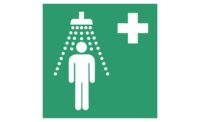Evaluate emergency eyewash and shower needs
Employers are advised to follow current OSHA regulations for emergency safety equipment.

OSHA says in an April 14, 2008 Letter of Interpretation (LOI) that “…the employer must determine if employees can or will be exposed during the course of their duties to hazardous materials in such a way that the protections of an eyewash or emergency shower would be necessary.” Essentially, OSHA expects the employer to determine the level of potential risk to employees and provide protection accordingly. What protection is appropriate should be based on a hazard assessment and exposure determination.
Hazard assessment
OSHA is very clear that employers must provide emergency eyewashes or showers if a person may be exposed to injurious corrosive materials. This seems pretty straightforward; however, since there are different kinds of chemicals that can cause adverse health effects, employers need to fully understand the properties of a chemical and the associated hazards to form a reasoned basis for determining if a chemical is, in fact, an injurious corrosive material.
Therefore, the first step is to conduct an assessment of the following:
Physical properties — liquids present the most common hazards, but solids, gases, vapors, and mists also may present hazards. A material may be considered hazardous if it can damage the skin or eyes, or be readily absorbed through the skin.
pH — In general, acids with pH less than 2.5 and alkalis with a pH greater than 11 will require immediate flushing to prevent bodily damage. For example, alkaline solutions tend to be more damaging to the eyes and skin than acidic solutions because they soak into tissue. Keep in mind, however, that a pH between those ranges for either the eyes or skin doesn’t necessarily mean that a material will not cause injury. For example, there is no known concentration of hydrofluoric acid that is considered “safe.” If there is potential for exposure to it at any concentration, immediate flushing is absolutely critical.
Temperature — certain materials can change composition or become volatile when subjected to temperature abuses.
Reactivity — consider how the chemical can damage the eyes and skin, but also how the chemical may react with other materials or chemicals in the immediate work area.
OSHA says employers should refer to the material’s Safety Data Sheet (SDS) when making this evaluation. For example, if the SDS indicates irritation only, an eyewash or shower may not be required. On the other hand, if the SDS states that burns, corneal damage, or blindness could happen, the material would be considered hazardous and an eyewash and possibly a shower must be provided.
Employers should also consult with the product manufacturer and sources such as the NIOSH “Pocket Guide to Chemical Hazards.” The guide lists the physical and chemical properties and health hazards for many different substances. If the entry for the material in question says “provide quick drench,” this would obviously be an indication that an eyewash or shower is needed.
Also, in a May 5, 2004 LOI, OSHA says that employers should consult references such as W. Morton Grant’s “Toxicology of the Eye” when considering potential chemical exposures to the eye and the appropriateness of installing eyewashes to protect employees against hazards associated with particular chemicals and substances.
Exposure determination
Again, 1910.151(c) says that, “Where the eyes or body of any person may be exposed to injurious corrosive materials, suitable facilities for quick drenching or flushing of the eyes and body have to be provided… .” That is key since an emergency eyewash or shower isn’t necessarily needed just because an employer possesses an injurious corrosive material.
In the April 14, 2008 LOI, OSHA also says that:
“If hazardous materials are present at a worksite in such a way that exposure could not occur (for example, in sealed containers that will not be opened, or caustic materials in building piping), then an eyewash or emergency shower would not be necessary. However, if the building piping containing caustic materials has, at certain locations, a spigot or tap from which the contents are to be sampled or withdrawn and employees are expected to perform such tasks, then, certainly, an eyewash and/or emergency shower would be needed where this task is to occur.”
Therefore, when determining exposure, an employer should evaluate the potential for the material to get into the eyes or on the skin.
Consider:
Type of equipment — The LOI referenced above specifically mentions piping containing caustic materials that have a spigot or tap from which the contents are withdrawn.
Use — Consider how employees work with chemicals during handling, transfer, use or disposal operations. All determinations of exposure should be made without regard to the use of personal protective equipment such as goggles, faceshields, gloves or aprons. Keep in mind that the use of PPE does not change the requirement for an eyewash or shower.
Worksite conditions — Temperature, fixed or non-fixed locations, the layout of the facility, etc. can play a role in exposure.
Also, the quantity of exposure must be considered. Could the amount of chemical present result in exposure to substantial portions of the body? If so, then a shower would be necessary to supply a sufficient volume of flushing fluid.
If, after completing these two steps, the employer determines that they have injurious corrosive chemicals and employees can be exposed, then they are required to provide an emergency eyewash and/or shower.
Looking for a reprint of this article?
From high-res PDFs to custom plaques, order your copy today!





